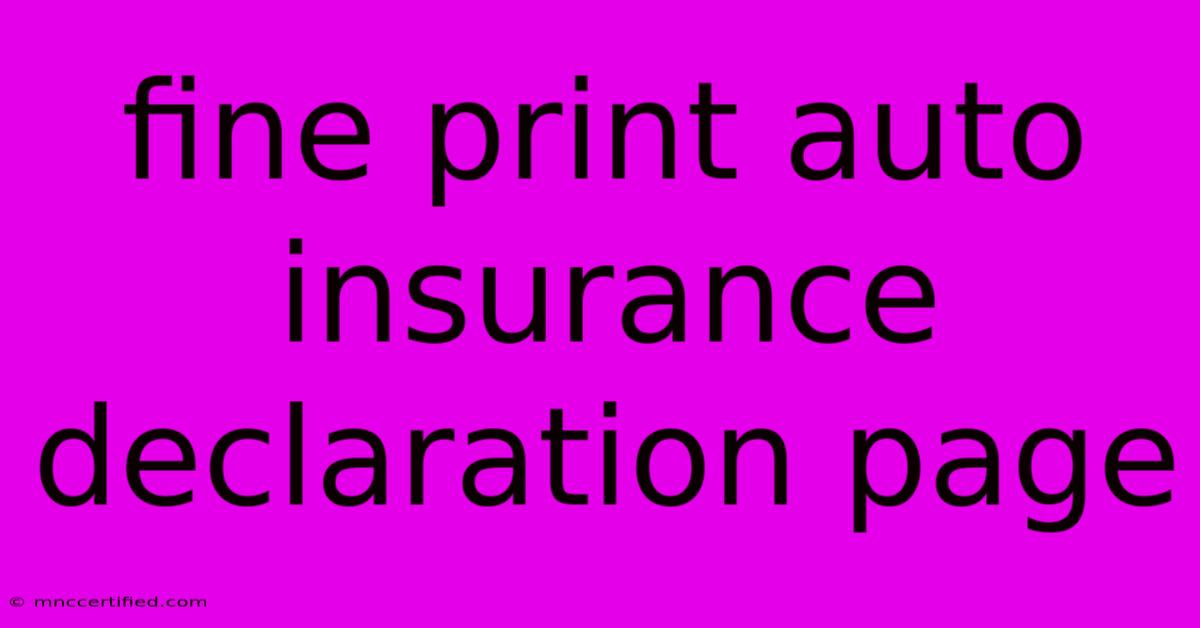Fine Print Auto Insurance Declaration Page

Table of Contents
Decoding the Fine Print: Understanding Your Auto Insurance Declaration Page
When you think of car insurance, the first thing that likely comes to mind is the premium you pay. But tucked away in your policy documents is a crucial piece of paper – the declaration page. This seemingly simple document contains vital information about your insurance coverage, and understanding its contents can save you from potential headaches down the road.
What is an Auto Insurance Declaration Page?
The declaration page is the summary of your car insurance policy. It's like a snapshot of your coverage, outlining key details such as:
- Your Policy Number: This is your unique identifier for the policy.
- Policy Dates: Shows the start and end dates of your insurance period.
- Insured Name and Address: Identifies the policyholder.
- Vehicle Information: Includes make, model, year, VIN, and any modifications.
- Coverage Details: Lists the types of coverage you have, like liability, collision, comprehensive, and uninsured/underinsured motorist coverage.
- Deductibles: Outlines the amounts you'll pay out-of-pocket before your insurance kicks in.
- Premium Amount: Shows your total insurance cost.
- Premium Payment Schedule: Indicates how often you pay your premium (monthly, quarterly, etc.).
Why the Declaration Page Matters
The declaration page is not just a boring document to be filed away. It's an essential tool for:
- Understanding Your Coverage: It's a quick reference guide to your policy's essential components.
- Making Informed Decisions: You can easily compare different coverage options and adjust them as needed.
- Filing Claims: The declaration page contains your policy details, making it easier for you to file a claim quickly and efficiently.
- Reviewing Your Policy: It's a good practice to review your declaration page regularly to ensure your coverage still meets your needs.
Key Terms to Know:
Coverage: The types of insurance you have, like liability, collision, and comprehensive.
Deductible: The amount you pay out-of-pocket before your insurance covers the remaining expenses.
Premium: The amount you pay for your car insurance.
The Importance of Fine Print:
The declaration page also includes fine print that can impact your coverage and rights. It's important to carefully read these sections, including:
- Exclusions: These are situations where your coverage might not apply.
- Limitations: These outline any caps on your benefits or specific conditions for coverage.
- Cancellation Clauses: This explains the circumstances under which you or the insurer can cancel the policy.
How to Get Your Declaration Page:
- Your Insurance Agent: Your agent can provide you with a copy of your declaration page.
- Your Insurance Company's Website: Many insurance companies allow you to access and download your declaration page online.
- Your Policy Documents: The declaration page should be included in your policy package.
Tips for Using Your Declaration Page:
- Read it Carefully: Don't skip over the fine print; it contains critical information about your coverage and rights.
- Keep it Organized: Store your declaration page in a safe and accessible place.
- Review it Regularly: Check your declaration page at least annually to ensure it still meets your needs.
- Ask Questions: If you don't understand anything on your declaration page, don't hesitate to contact your agent or insurance company.
By taking the time to understand your auto insurance declaration page, you can gain valuable insights into your coverage and make informed decisions about your car insurance policy. This knowledge will help you navigate potential claims and ensure that you have the protection you need on the road.

Thank you for visiting our website wich cover about Fine Print Auto Insurance Declaration Page. We hope the information provided has been useful to you. Feel free to contact us if you have any questions or need further assistance. See you next time and dont miss to bookmark.
Featured Posts
-
Barcelona Vs Red Star Lineups And Predictions
Nov 07, 2024
-
Weeks To Live Trevor Sorbies Bowel Cancer
Nov 07, 2024
-
Ny Man Faces Charges For Terrorism Aid
Nov 07, 2024
-
South Dakota Crop Insurance Planting Dates
Nov 07, 2024
-
Leeds Vs Millwall 0 0 15 Minutes In
Nov 07, 2024